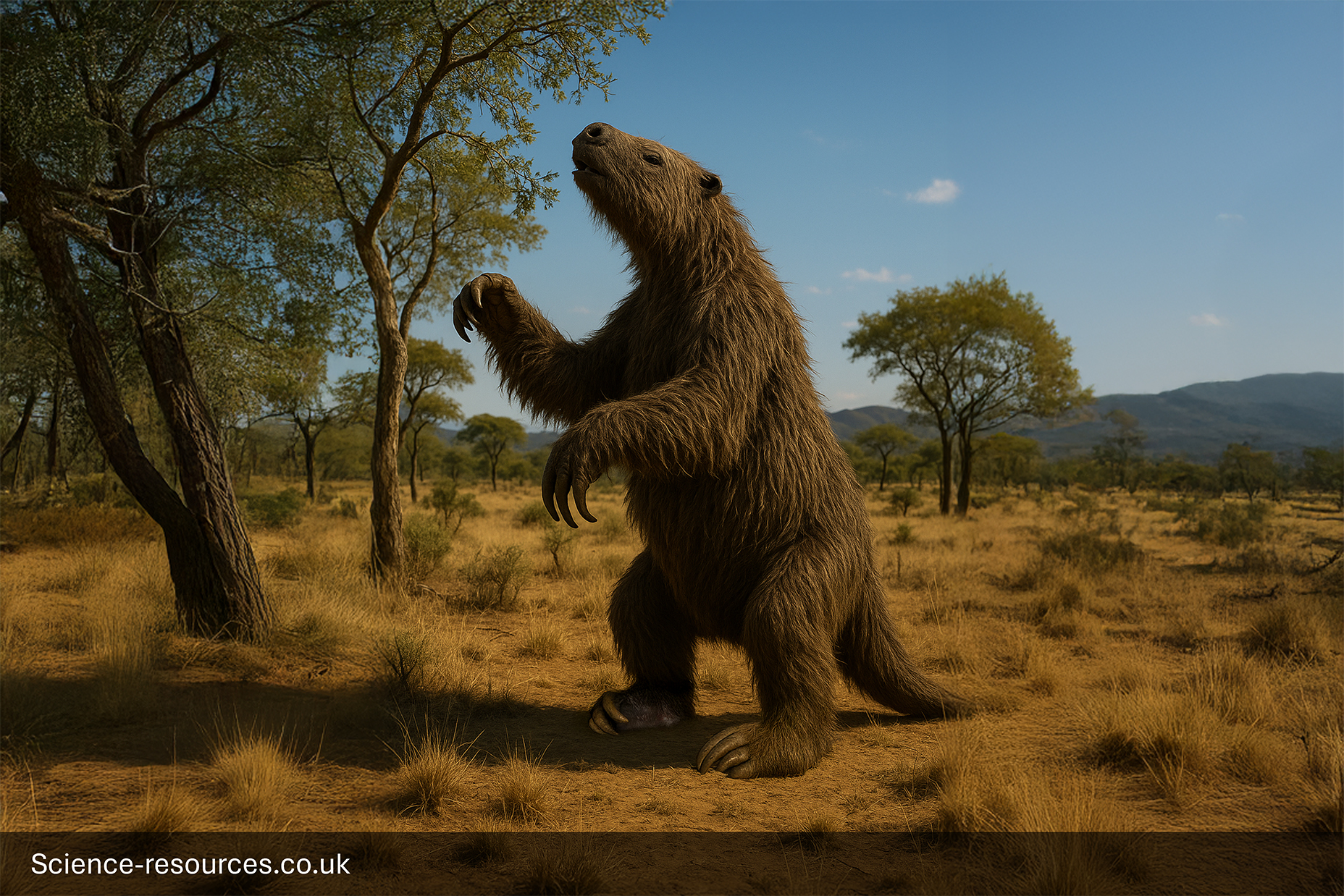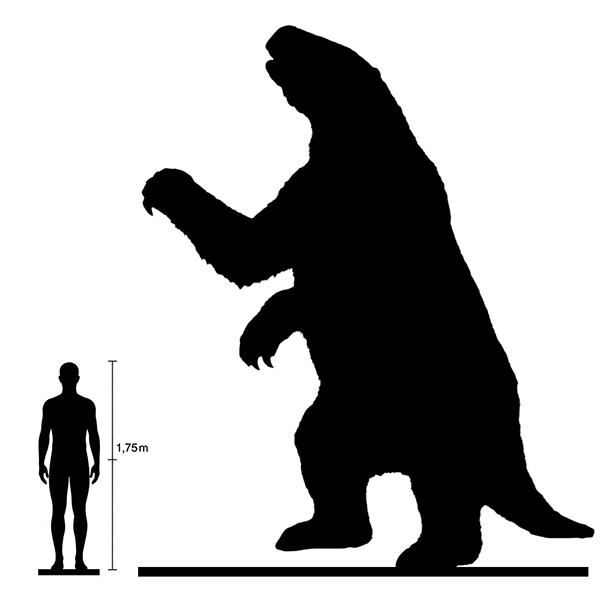Last updated: 4th August 2025
Extinct Animals: Megatherium
Megatherium, the giant ground sloth, was one of the largest land mammals to have ever lived.
Megatherium (Giant Ground Sloth)
 Megatherium
Megatherium
Generative AI Notification: Some elements of this image have been created or enhanced using AI technology. To find out how we create all our prehistoric animals, click here.
What is Megatherium?
Megatherium was a genus of elephant-sized ground sloths that lived in South America during the Pliocene and Pleistocene epochs. It was a distant, but colossal, relative of modern tree sloths and armadillos.
How big was Megatherium?
It could reach up to 6 meters (20 feet) in length from head to tail and weighed up to 4 tons, making it a truly colossal and formidable herbivore.
What did Megatherium eat?
It was a herbivore, using its long claws and powerful body to pull down tree branches and strip them of their leaves and other vegetation. Its diet also likely included roots and grasses.
Megatherium appearance
Megatherium had a heavy build, long, powerful forelimbs with impressive claws, and a thick, shaggy coat. It possessed a large, muscular tail that, along with its hind legs, allowed it to stand upright for feeding or defense.
Where did Megatherium live?
Fossils have been found in South America, from the southern plains of Patagonia to as far north as Argentina. It thrived in a variety of environments, from forests to open plains.
Interesting facts
The impressive size and power of Megatherium likely made it a formidable animal that even top predators like Smilodon would have hesitated to attack. Its extinction around 10,000 years ago coincided with the arrival of humans in South America.

Megatherium Facts
Pronounced: meg-uh-THEER-ee-um
Name Means: "Great Beast"
Length: Up to 6 meters (20 feet)
Height: Around 4 meters (13 feet) when standing upright
Weight: Up to 4,000 kilograms (8,800 pounds)
Diet: Herbivore (Plants)
Time: Pleistocene Epoch (about 2 million to 10,000 years ago)
Fossils Found: South America (primarily Argentina, Bolivia, and Brazil)
Which family of animals did Megatherium belong to?
It belonged to the family Megatheriidae, an extinct family of giant ground sloths, which were part of the superorder Xenarthra, a group that also includes armadillos and anteaters.
What other animals lived at the same time as Megatherium?
It shared its habitat with other Ice Age megafauna, including the saber-toothed cat Smilodon and the armored Glyptodons Doedicurus, creating a unique and diverse prehistoric ecosystem.
Megatherium FAQ
Q1: What was Megatherium?
A1: Megatherium was a genus of giant ground sloths that lived during the Pleistocene Epoch. It was one of the largest land mammals ever to exist.
Q2: How big was Megatherium?
A2: Megatherium could grow up to 6 meters (20 feet) in length and weigh as much as 4,000 kilograms (8,800 pounds). When standing on its hind legs, it could reach heights of around 4 meters (13 feet).
Q3: What did Megatherium eat?
A3: It was an herbivore, feeding primarily on leaves, fruits, and possibly soft vegetation. Some theories suggest it may have used its large claws to pull down branches or dig for roots.
Q4: Where did Megatherium live?
A4: Fossils have been found mainly in South America, especially in Argentina, Bolivia, and Brazil. It lived in open woodland and grassland environments.
Q5: When did Megatherium live?
A5: Megatherium lived from around 2 million years ago until about 10,000 years ago, during the Pleistocene Epoch.
Q6: Did Megatherium have any predators?
A6: Adult Megatherium likely had few natural predators due to its size. However, it may have been hunted by early humans, which could have contributed to its extinction.
Q7: How did Megatherium move?
A7: It was primarily quadrupedal but could stand and walk on its hind legs for short periods, especially when feeding or defending itself.
Q8: Why did Megatherium go extinct?
A8: The exact cause is unknown, but likely factors include climate change at the end of the Ice Age and hunting by humans.
Q9: Is Megatherium related to modern sloths?
A9: Yes! Megatherium is part of the sloth family tree. Though much larger, it shares ancestry with today’s much smaller tree-dwelling sloths.
Q10: What makes Megatherium special?
A10: Its massive size, unique skeletal structure, and close evolutionary ties to modern sloths make it a standout example of Ice Age megafauna.
You may also be intrested in:
- Extinct Animals: A-Z
- Dinosaurs: A-Z
Tags: How big was Megatherium, Megatherium size, where did Megatherium live, how tall was Megatherium, what does Megatherium mean, Megatherium facts
Previous: Megalodon
Up next: Phorusrhacos
© 2012 science-resources.co.uk. All rights reserved | Design by W3layouts
Extinct Animals: Megatherium
Megatherium, the giant ground sloth, was one of the largest land mammals to have ever lived.
Megatherium (Giant Ground Sloth)
 Megatherium
Megatherium
Generative AI Notification: Some elements of this image have been created or enhanced using AI technology. To find out how we create all our prehistoric animals, click here.
What is Megatherium?
Megatherium was a genus of elephant-sized ground sloths that lived in South America during the Pliocene and Pleistocene epochs. It was a distant, but colossal, relative of modern tree sloths and armadillos.
How big was Megatherium?
It could reach up to 6 meters (20 feet) in length from head to tail and weighed up to 4 tons, making it a truly colossal and formidable herbivore.
What did Megatherium eat?
It was a herbivore, using its long claws and powerful body to pull down tree branches and strip them of their leaves and other vegetation. Its diet also likely included roots and grasses.
Megatherium appearance
Megatherium had a heavy build, long, powerful forelimbs with impressive claws, and a thick, shaggy coat. It possessed a large, muscular tail that, along with its hind legs, allowed it to stand upright for feeding or defense.
Where did Megatherium live?
Fossils have been found in South America, from the southern plains of Patagonia to as far north as Argentina. It thrived in a variety of environments, from forests to open plains.
Interesting facts
The impressive size and power of Megatherium likely made it a formidable animal that even top predators like Smilodon would have hesitated to attack. Its extinction around 10,000 years ago coincided with the arrival of humans in South America.

Megatherium Facts
Pronounced: meg-uh-THEER-ee-um
Name Means: "Great Beast"
Length: Up to 6 meters (20 feet)
Height: Around 4 meters (13 feet) when standing upright
Weight: Up to 4,000 kilograms (8,800 pounds)
Diet: Herbivore (Plants)
Time: Pleistocene Epoch (about 2 million to 10,000 years ago)
Fossils Found: South America (primarily Argentina, Bolivia, and Brazil)
Which family of animals did Megatherium belong to?
It belonged to the family Megatheriidae, an extinct family of giant ground sloths, which were part of the superorder Xenarthra, a group that also includes armadillos and anteaters.
What other animals lived at the same time as Megatherium?
It shared its habitat with other Ice Age megafauna, including the saber-toothed cat Smilodon and the armored Glyptodons Doedicurus, creating a unique and diverse prehistoric ecosystem.
Megatherium FAQ
Q1: What was Megatherium?
A1: Megatherium was a genus of giant ground sloths that lived during the Pleistocene Epoch. It was one of the largest land mammals ever to exist.
Q2: How big was Megatherium?
A2: Megatherium could grow up to 6 meters (20 feet) in length and weigh as much as 4,000 kilograms (8,800 pounds). When standing on its hind legs, it could reach heights of around 4 meters (13 feet).
Q3: What did Megatherium eat?
A3: It was an herbivore, feeding primarily on leaves, fruits, and possibly soft vegetation. Some theories suggest it may have used its large claws to pull down branches or dig for roots.
Q4: Where did Megatherium live?
A4: Fossils have been found mainly in South America, especially in Argentina, Bolivia, and Brazil. It lived in open woodland and grassland environments.
Q5: When did Megatherium live?
A5: Megatherium lived from around 2 million years ago until about 10,000 years ago, during the Pleistocene Epoch.
Q6: Did Megatherium have any predators?
A6: Adult Megatherium likely had few natural predators due to its size. However, it may have been hunted by early humans, which could have contributed to its extinction.
Q7: How did Megatherium move?
A7: It was primarily quadrupedal but could stand and walk on its hind legs for short periods, especially when feeding or defending itself.
Q8: Why did Megatherium go extinct?
A8: The exact cause is unknown, but likely factors include climate change at the end of the Ice Age and hunting by humans.
Q9: Is Megatherium related to modern sloths?
A9: Yes! Megatherium is part of the sloth family tree. Though much larger, it shares ancestry with today’s much smaller tree-dwelling sloths.
Q10: What makes Megatherium special?
A10: Its massive size, unique skeletal structure, and close evolutionary ties to modern sloths make it a standout example of Ice Age megafauna.
Tags: How big was Megatherium, Megatherium size, where did Megatherium live, how tall was Megatherium, what does Megatherium mean, Megatherium facts
Previous: Megalodon
Up next: Phorusrhacos
© 2012 science-resources.co.uk. All rights reserved | Design by W3layouts